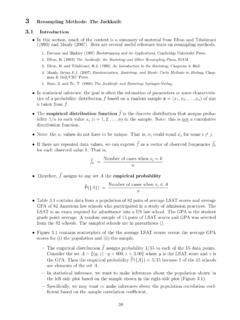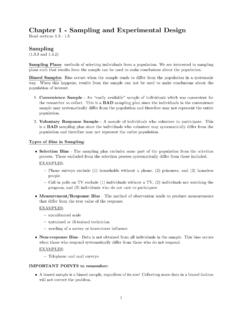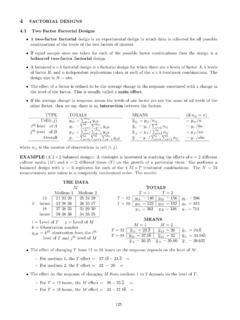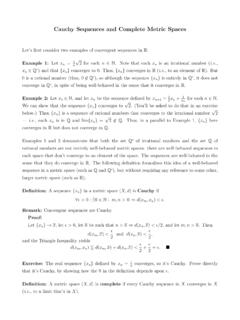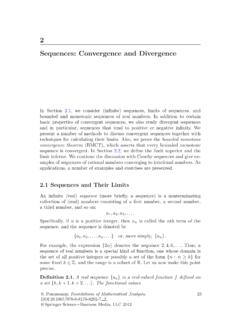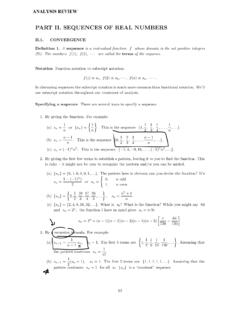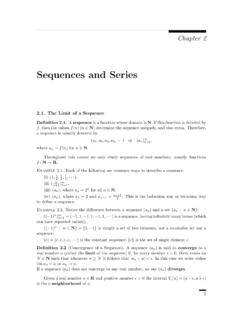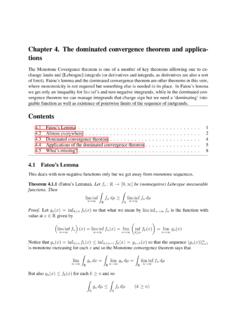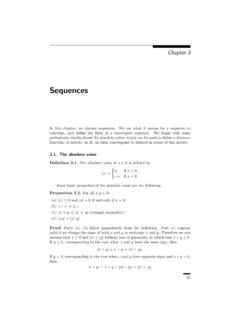Transcription of Proof.
1 Homework 4, 5, 6 (a)limn an= >0. Then forn n = 2+12 we have 2n 3 4+1 3>1 >0,so 0<12n 3< , and thus|an 0|=12n 3< . (g)limn ( n+ 1 n) = >0. Then forn n =14 2we have 2 n 1 >0, and so|an 0|= n+ 1 n=( n+1 n)( n+1+ n) n+1+ n=1 n+1+ n<12 n . (k)The sequencean={1ifnis odd1/nifnis not. Then the sequence converges to some limitA R. Bydefinition of convergence (with = 1/4) there existsn such that|an A|<1/4 forn n . Choose an integerk n /2. Then 2k n and 2k+1 n ,so|a2k A|<1/4 and|a2k+1 A|<1/4. So|1/(2k) A|<1/4 and|1 A|<1/4. The second inequality impliesA>3/4, and the first oneA<1/(2k) + 1/4 1/2 + 1/4 = 3/4.}
2 This is a contradiction, so thestatement is proved. limn a2n=Aand limn a2n 1=A, then limn an= >0. Then there existn1andn2such that|a2n A|< forn n1and|a2n 1 A|< forn n2. Letn = max(2n1,2n2 1), and letn n be arbitrary. Ifnis even, then there existsk Nsuch thatn= n 2n1we get thatk n1, and thus|an A|=|a2k A|< . Ifnis odd, then there existsk Nsuch thatn= 2k 1. Sincen n 2n2 1,we getk n2, and thus|an A|=|a2k 1 A|< . Every numberniseither even or odd, so we have proved the claim. The converse is also true: If limn an=A, then limn a2n= limn a2n 1= >0.
3 Then there existsn1such that|an A|< forn n = (n1+ 1)/2 we get 2n 2n 1 n1and thus|a2n A|< and|a2n 1 A|< . This shows the claim. The first direction helps with 2(j), since limn a2n= limn 1/(2n) = 0 andlimn a2n 1= 0, so the results implies that the sequence converges to converse helps with 2(k), since limn a2n= limn 1/(2n) = 0 and limn a2n 1=1. If the sequence would converge, these two limits would have to be thesame. Since they are different, the sequence itself {an}converges toA, then the sequence {bn}defined bybn=(an+an+1)/2 converges toA, >0.
4 Then there existsn such that|an A|< forn n .Then|bn A|=|(an+an+1)/2 A|=|(an A) + (an+1 A)|/2 |an A|/2 +|an+1 A|/2< /2 + /2 = forn n . sequences{an}and{bn}, wherebn=n an.(a)If{bn}converges to 1, does the sequence {an}necessarily converge?No. Example isan=n,bn=n n.(b)If{bn}converges to 1, does the sequence {an}necessarily diverge?No. Example isan=bn= 1.(c)Does{bn}have to converge to 1?No. Example isan=bn= (c)limn 12n= 0 by Theorem (d)limn rnn!= will writean=rnn!. Choosen1 Nwithn1 |r|. LetM=|an1|=|r|n1n1!=|r|1 |r|2 |r| first claim that|an| Mfor alln n1.
5 Proof by induction: The casen=n1is immediate by definition ofM. Now if we already know the claimfor somen n1, then|an+1|=|r|n+1(n+ 1)!=|r|nn! |r|n+ 1 M|r|n+ 1 M.(We usedn+1 n1 |r|in the last inequality, and the induction hypothesisin the second-to-last inequality.) Now letn>n1be arbitrary. Thenn 1 n , so|r|n 1(n 1)! M, and thus|an|=|r|nn!=|r|n 1(n 1)! |r|n M|r| know that limn M|r|n= 0. The squeeze theorem then implies that{an}converges to 0, too. (i)limn n n+ n= follows from the squeeze theorem, the estimate 1 n n+ n n 2n=n 2 n n, and limn n 2 = limn n n= 1.
6 (a)Suppose that{an}and{anbn}both converge, andan6= 0 forlargen. Is it true that{bn}must converge?No. Example:an= 1/n,bn= (b)Suppose that{an}converges to a non-zero number and{anbn}converges. Prove that{bn}must also follows immediately from the limit theorems. LetA= limn anandC= limn anbn. Thenbn=anbnanis the quotient of two convergentsequences, where the denominator converges to a non-zero limit. From The-orem (c) we get that{bn}converges toC/A. (a)Is it possible to have an unbounded sequence {an}such thatlimn an/n= 0?Yes. Examplean= (b)Prove that if the sequence {an}satisfies limn an/n=L6= 0, then{an}is not.
7 Then there existsMsuch that|an| Mfor alln, andthus|an/n| M/n. We know limn M/n= 0, and the squeeze theoremimplies limn an/n= 0, contradicting the assumption. 0 , then limn n+ n= . is again the squeeze theorem. We know n n+ n 2 n, so n n+ n n 2 . In class we proved limn n 2 = 1, so the sequencein the middle of the inequalities also has to converge to . the Comparison Theorem: If{an}diverges to + , andan bnforn n1, then{bn}also diverges to + . >0 be arbitrary. Then there existsn2such thatan>Mforn n2. Forn n = max(n1,n2) we getbn an>M.
8 (a)Prove thatan= (n2+ 1)/(n 2) diverges to + . 3 we havean n2/n=n, and we already know thatlimn n= + . By comparison theorem{an}diverges to + , too. an example of a sequence that diverges to + but is not even-tually + ( 1) an example of a converging sequence that does not attain amaximum 1 (a)Let the sequence {an}be recursively defined bya1= 6 andan+1= 6 +anforn N. Find the limit if it claim: The sequence is increasing. Proof by induction:a2= 6 + 6 6 =a1. Assume that we knowan+1 an. Thenan+2= 6 +an+1 6 +an=an+ claim: The sequence is bounded by 30.
9 Proof by induction:a1= 6 30. If we knowan 30, thenan+1= 6 +an 6 + 30 = 6 know that monotone bounded sequences converge, so there exists somelimitA R. We can pass to the limit in the recursive equation to getA= limn an+1= limn 6 +an= 6 +Aby limit theorems. From theequationA= 6 +Awe see thatA 0, and thatA2= 6 +A. The twosolutions of this equation are 2 and 3, and sinceA 0, we getA= (g)Same question as previous problem fora1= 1 andan+1= 1 + claim: The sequence is increasing. Proof by induction:a2= 1+1/2 1 =a1. Assuming that we knowan+1 an, we getan+2= 1 +an+1/2 1 +an/2 =an+ claim: The sequence is bounded by 30.
10 Proof by induction:a1=1 30. Assuming we knowan 30, we getan+1= 1 +an/2 1 + 30/2 =16 we know that the sequence converges to some limitA Rbecauseit is monotone and bounded. Passing to the limit in the recursive equationwe getA= limn an+1= limn (1 +an/2) = 1 +A/2 by limit theorems. TheequationA= 1 +A/2 has only one solutionA= 2, so the limit is an accumulation point ofS. Prove that the following twostatements are equivalent.(a)Any neighborhood ofs0contains at least one point ofSdifferent froms0.(b)Any neighborhood ofs0contains infinitely many points statement of this problem is unfortunately slightly screwed up.
